Healthcare Law: Documentation Standards and Compliance in Canada
VerifiedAdded on 2022/09/05
|8
|2056
|12
Report
AI Summary
This report discusses the documentation practices within the Canadian healthcare system, focusing on the legislative and professional standards that govern clinical record documentation. It highlights the importance of multidisciplinary care and the role of electronic health service solutions in improving clinical documentation and compliance. The report identifies specific documentation standards, including recording client needs, clinical problems, assessment findings, and medication administration details. It also explores the procedures and policies used to ensure adherence to these standards, such as audits, supervisor feedback, and staff training. The report addresses the use of abbreviations in clinical documentation and identifies gaps in current policies, such as the lack of clear discrimination between paper and electronic documentation. It concludes by emphasizing the importance of health information management in clinical practice and suggesting strategies for improving documentation adherence through regular seminars, workshops, and training sessions. The influence of health information technology on Canadian healthcare and the standardization of clinical procedures are also underscored.
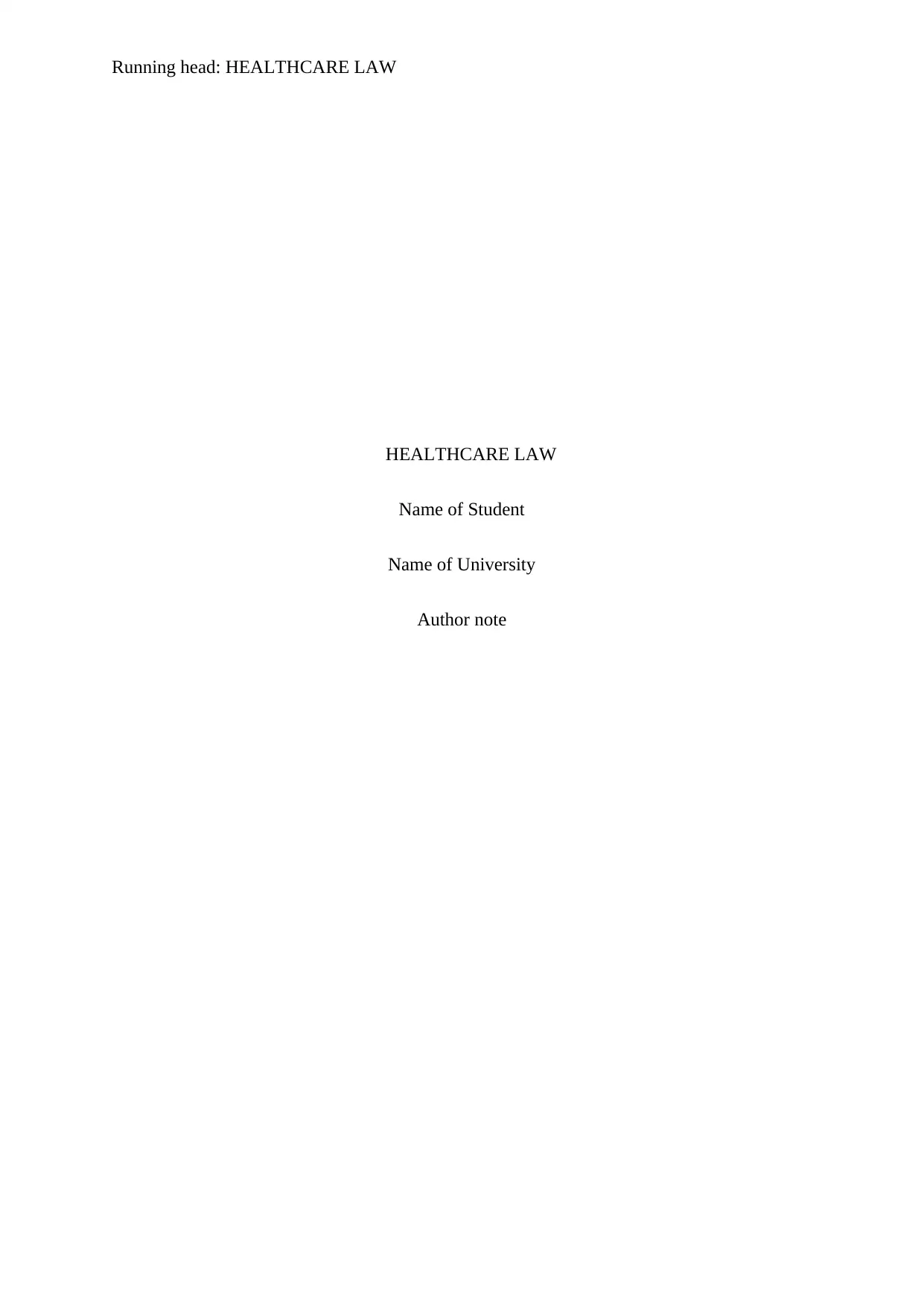
Running head: HEALTHCARE LAW
HEALTHCARE LAW
Name of Student
Name of University
Author note
HEALTHCARE LAW
Name of Student
Name of University
Author note
Paraphrase This Document
Need a fresh take? Get an instant paraphrase of this document with our AI Paraphraser
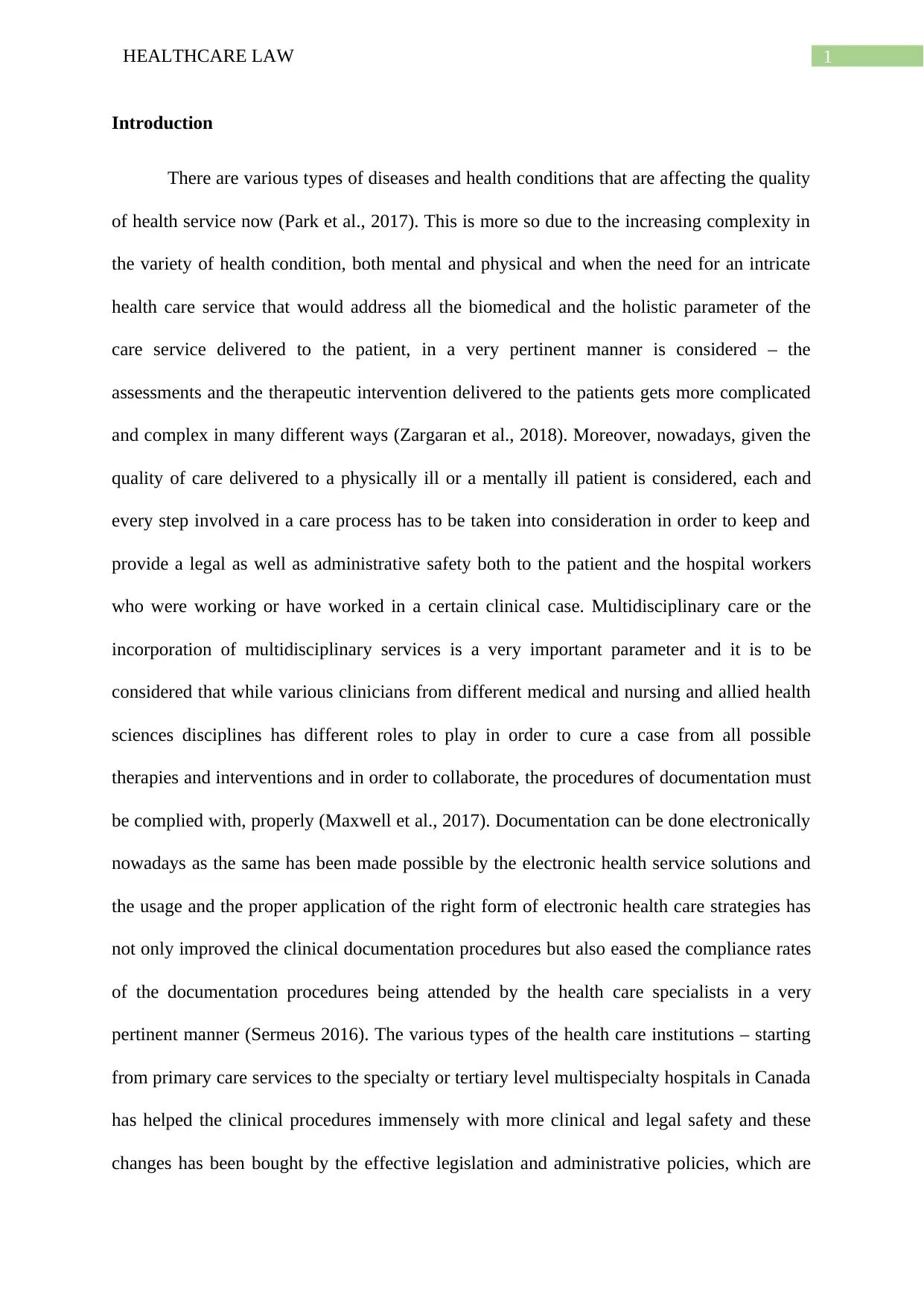
1HEALTHCARE LAW
Introduction
There are various types of diseases and health conditions that are affecting the quality
of health service now (Park et al., 2017). This is more so due to the increasing complexity in
the variety of health condition, both mental and physical and when the need for an intricate
health care service that would address all the biomedical and the holistic parameter of the
care service delivered to the patient, in a very pertinent manner is considered – the
assessments and the therapeutic intervention delivered to the patients gets more complicated
and complex in many different ways (Zargaran et al., 2018). Moreover, nowadays, given the
quality of care delivered to a physically ill or a mentally ill patient is considered, each and
every step involved in a care process has to be taken into consideration in order to keep and
provide a legal as well as administrative safety both to the patient and the hospital workers
who were working or have worked in a certain clinical case. Multidisciplinary care or the
incorporation of multidisciplinary services is a very important parameter and it is to be
considered that while various clinicians from different medical and nursing and allied health
sciences disciplines has different roles to play in order to cure a case from all possible
therapies and interventions and in order to collaborate, the procedures of documentation must
be complied with, properly (Maxwell et al., 2017). Documentation can be done electronically
nowadays as the same has been made possible by the electronic health service solutions and
the usage and the proper application of the right form of electronic health care strategies has
not only improved the clinical documentation procedures but also eased the compliance rates
of the documentation procedures being attended by the health care specialists in a very
pertinent manner (Sermeus 2016). The various types of the health care institutions – starting
from primary care services to the specialty or tertiary level multispecialty hospitals in Canada
has helped the clinical procedures immensely with more clinical and legal safety and these
changes has been bought by the effective legislation and administrative policies, which are
Introduction
There are various types of diseases and health conditions that are affecting the quality
of health service now (Park et al., 2017). This is more so due to the increasing complexity in
the variety of health condition, both mental and physical and when the need for an intricate
health care service that would address all the biomedical and the holistic parameter of the
care service delivered to the patient, in a very pertinent manner is considered – the
assessments and the therapeutic intervention delivered to the patients gets more complicated
and complex in many different ways (Zargaran et al., 2018). Moreover, nowadays, given the
quality of care delivered to a physically ill or a mentally ill patient is considered, each and
every step involved in a care process has to be taken into consideration in order to keep and
provide a legal as well as administrative safety both to the patient and the hospital workers
who were working or have worked in a certain clinical case. Multidisciplinary care or the
incorporation of multidisciplinary services is a very important parameter and it is to be
considered that while various clinicians from different medical and nursing and allied health
sciences disciplines has different roles to play in order to cure a case from all possible
therapies and interventions and in order to collaborate, the procedures of documentation must
be complied with, properly (Maxwell et al., 2017). Documentation can be done electronically
nowadays as the same has been made possible by the electronic health service solutions and
the usage and the proper application of the right form of electronic health care strategies has
not only improved the clinical documentation procedures but also eased the compliance rates
of the documentation procedures being attended by the health care specialists in a very
pertinent manner (Sermeus 2016). The various types of the health care institutions – starting
from primary care services to the specialty or tertiary level multispecialty hospitals in Canada
has helped the clinical procedures immensely with more clinical and legal safety and these
changes has been bought by the effective legislation and administrative policies, which are
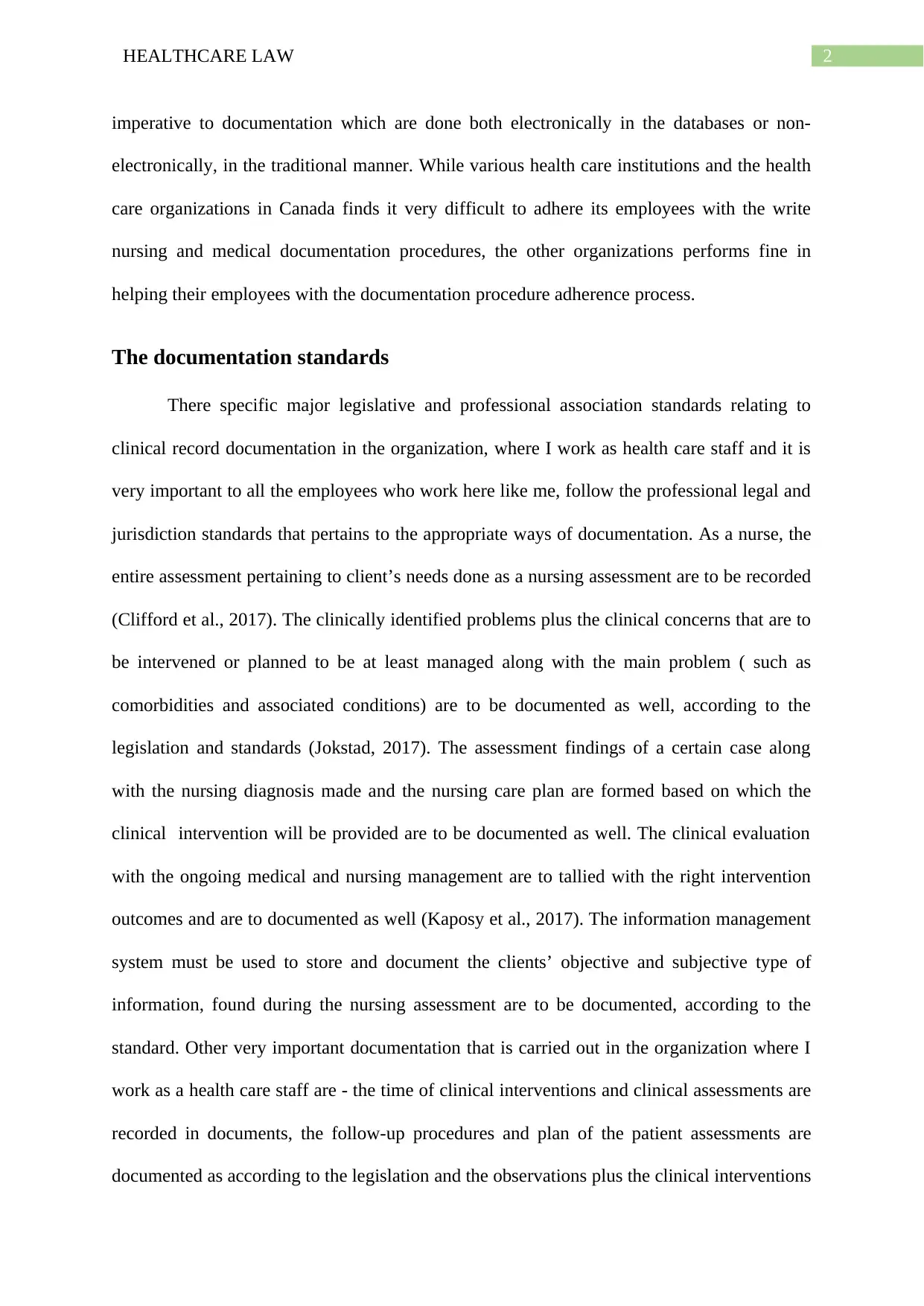
2HEALTHCARE LAW
imperative to documentation which are done both electronically in the databases or non-
electronically, in the traditional manner. While various health care institutions and the health
care organizations in Canada finds it very difficult to adhere its employees with the write
nursing and medical documentation procedures, the other organizations performs fine in
helping their employees with the documentation procedure adherence process.
The documentation standards
There specific major legislative and professional association standards relating to
clinical record documentation in the organization, where I work as health care staff and it is
very important to all the employees who work here like me, follow the professional legal and
jurisdiction standards that pertains to the appropriate ways of documentation. As a nurse, the
entire assessment pertaining to client’s needs done as a nursing assessment are to be recorded
(Clifford et al., 2017). The clinically identified problems plus the clinical concerns that are to
be intervened or planned to be at least managed along with the main problem ( such as
comorbidities and associated conditions) are to be documented as well, according to the
legislation and standards (Jokstad, 2017). The assessment findings of a certain case along
with the nursing diagnosis made and the nursing care plan are formed based on which the
clinical intervention will be provided are to be documented as well. The clinical evaluation
with the ongoing medical and nursing management are to tallied with the right intervention
outcomes and are to documented as well (Kaposy et al., 2017). The information management
system must be used to store and document the clients’ objective and subjective type of
information, found during the nursing assessment are to be documented, according to the
standard. Other very important documentation that is carried out in the organization where I
work as a health care staff are - the time of clinical interventions and clinical assessments are
recorded in documents, the follow-up procedures and plan of the patient assessments are
documented as according to the legislation and the observations plus the clinical interventions
imperative to documentation which are done both electronically in the databases or non-
electronically, in the traditional manner. While various health care institutions and the health
care organizations in Canada finds it very difficult to adhere its employees with the write
nursing and medical documentation procedures, the other organizations performs fine in
helping their employees with the documentation procedure adherence process.
The documentation standards
There specific major legislative and professional association standards relating to
clinical record documentation in the organization, where I work as health care staff and it is
very important to all the employees who work here like me, follow the professional legal and
jurisdiction standards that pertains to the appropriate ways of documentation. As a nurse, the
entire assessment pertaining to client’s needs done as a nursing assessment are to be recorded
(Clifford et al., 2017). The clinically identified problems plus the clinical concerns that are to
be intervened or planned to be at least managed along with the main problem ( such as
comorbidities and associated conditions) are to be documented as well, according to the
legislation and standards (Jokstad, 2017). The assessment findings of a certain case along
with the nursing diagnosis made and the nursing care plan are formed based on which the
clinical intervention will be provided are to be documented as well. The clinical evaluation
with the ongoing medical and nursing management are to tallied with the right intervention
outcomes and are to documented as well (Kaposy et al., 2017). The information management
system must be used to store and document the clients’ objective and subjective type of
information, found during the nursing assessment are to be documented, according to the
standard. Other very important documentation that is carried out in the organization where I
work as a health care staff are - the time of clinical interventions and clinical assessments are
recorded in documents, the follow-up procedures and plan of the patient assessments are
documented as according to the legislation and the observations plus the clinical interventions
⊘ This is a preview!⊘
Do you want full access?
Subscribe today to unlock all pages.

Trusted by 1+ million students worldwide
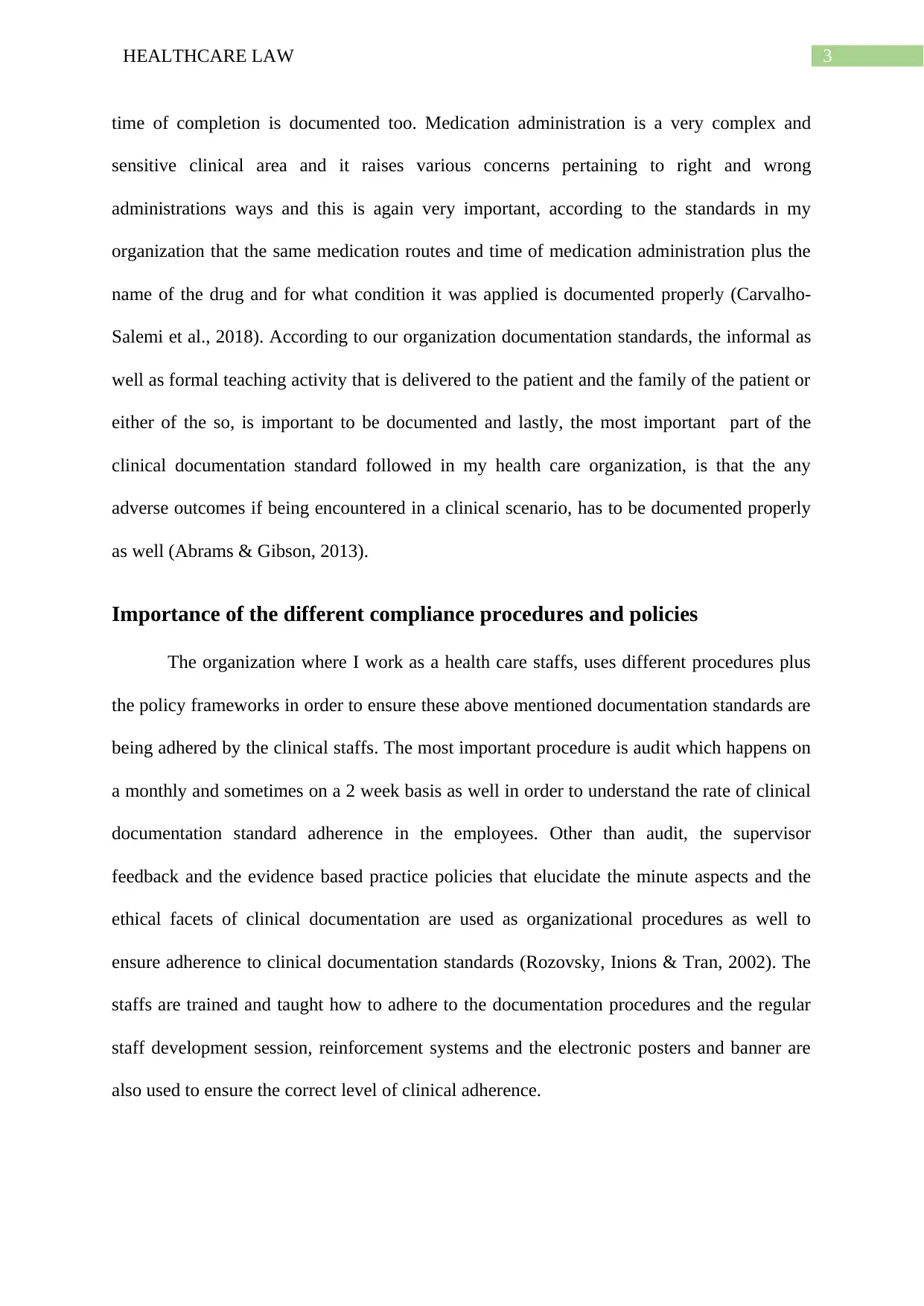
3HEALTHCARE LAW
time of completion is documented too. Medication administration is a very complex and
sensitive clinical area and it raises various concerns pertaining to right and wrong
administrations ways and this is again very important, according to the standards in my
organization that the same medication routes and time of medication administration plus the
name of the drug and for what condition it was applied is documented properly (Carvalho-
Salemi et al., 2018). According to our organization documentation standards, the informal as
well as formal teaching activity that is delivered to the patient and the family of the patient or
either of the so, is important to be documented and lastly, the most important part of the
clinical documentation standard followed in my health care organization, is that the any
adverse outcomes if being encountered in a clinical scenario, has to be documented properly
as well (Abrams & Gibson, 2013).
Importance of the different compliance procedures and policies
The organization where I work as a health care staffs, uses different procedures plus
the policy frameworks in order to ensure these above mentioned documentation standards are
being adhered by the clinical staffs. The most important procedure is audit which happens on
a monthly and sometimes on a 2 week basis as well in order to understand the rate of clinical
documentation standard adherence in the employees. Other than audit, the supervisor
feedback and the evidence based practice policies that elucidate the minute aspects and the
ethical facets of clinical documentation are used as organizational procedures as well to
ensure adherence to clinical documentation standards (Rozovsky, Inions & Tran, 2002). The
staffs are trained and taught how to adhere to the documentation procedures and the regular
staff development session, reinforcement systems and the electronic posters and banner are
also used to ensure the correct level of clinical adherence.
time of completion is documented too. Medication administration is a very complex and
sensitive clinical area and it raises various concerns pertaining to right and wrong
administrations ways and this is again very important, according to the standards in my
organization that the same medication routes and time of medication administration plus the
name of the drug and for what condition it was applied is documented properly (Carvalho-
Salemi et al., 2018). According to our organization documentation standards, the informal as
well as formal teaching activity that is delivered to the patient and the family of the patient or
either of the so, is important to be documented and lastly, the most important part of the
clinical documentation standard followed in my health care organization, is that the any
adverse outcomes if being encountered in a clinical scenario, has to be documented properly
as well (Abrams & Gibson, 2013).
Importance of the different compliance procedures and policies
The organization where I work as a health care staffs, uses different procedures plus
the policy frameworks in order to ensure these above mentioned documentation standards are
being adhered by the clinical staffs. The most important procedure is audit which happens on
a monthly and sometimes on a 2 week basis as well in order to understand the rate of clinical
documentation standard adherence in the employees. Other than audit, the supervisor
feedback and the evidence based practice policies that elucidate the minute aspects and the
ethical facets of clinical documentation are used as organizational procedures as well to
ensure adherence to clinical documentation standards (Rozovsky, Inions & Tran, 2002). The
staffs are trained and taught how to adhere to the documentation procedures and the regular
staff development session, reinforcement systems and the electronic posters and banner are
also used to ensure the correct level of clinical adherence.
Paraphrase This Document
Need a fresh take? Get an instant paraphrase of this document with our AI Paraphraser
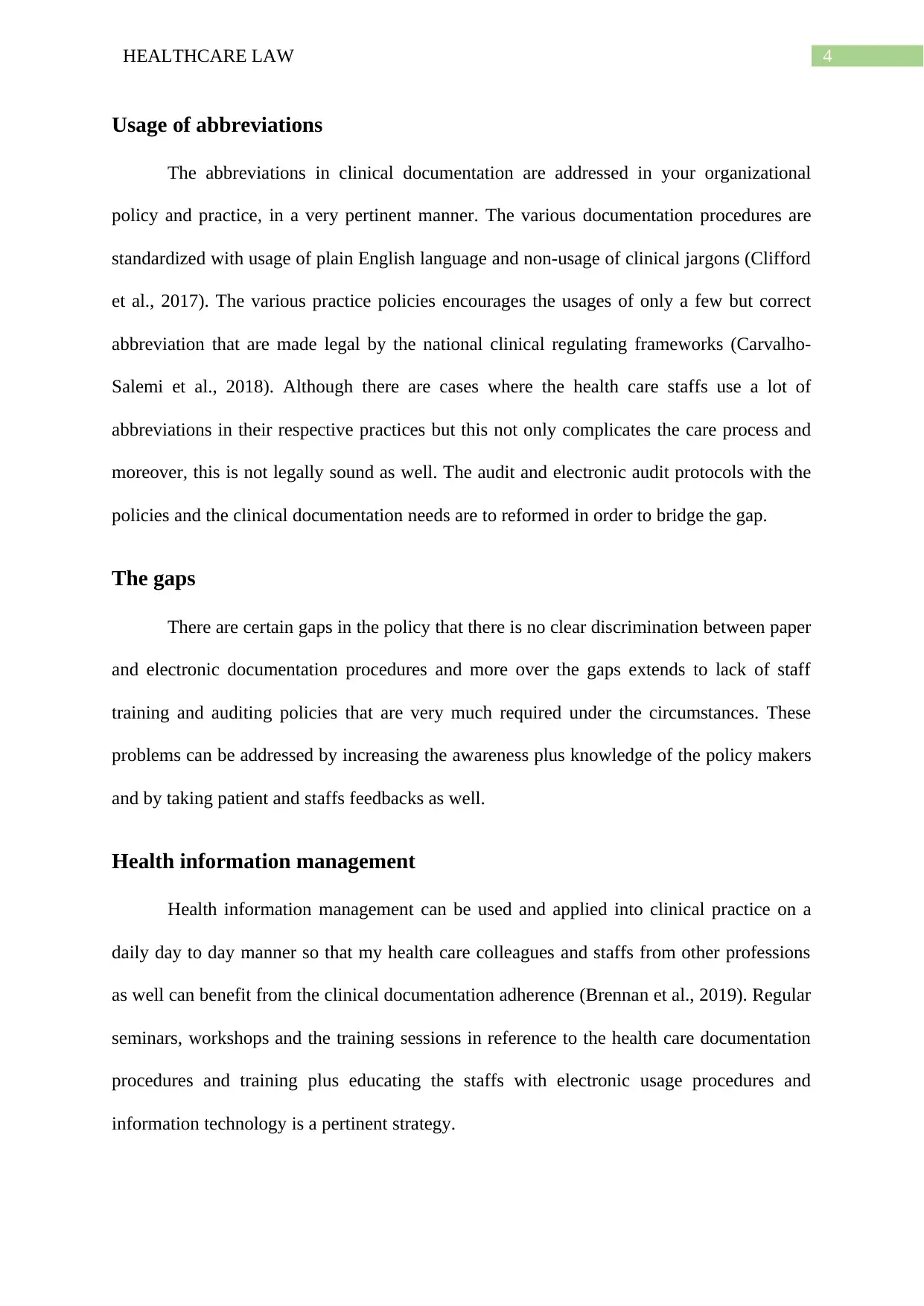
4HEALTHCARE LAW
Usage of abbreviations
The abbreviations in clinical documentation are addressed in your organizational
policy and practice, in a very pertinent manner. The various documentation procedures are
standardized with usage of plain English language and non-usage of clinical jargons (Clifford
et al., 2017). The various practice policies encourages the usages of only a few but correct
abbreviation that are made legal by the national clinical regulating frameworks (Carvalho-
Salemi et al., 2018). Although there are cases where the health care staffs use a lot of
abbreviations in their respective practices but this not only complicates the care process and
moreover, this is not legally sound as well. The audit and electronic audit protocols with the
policies and the clinical documentation needs are to reformed in order to bridge the gap.
The gaps
There are certain gaps in the policy that there is no clear discrimination between paper
and electronic documentation procedures and more over the gaps extends to lack of staff
training and auditing policies that are very much required under the circumstances. These
problems can be addressed by increasing the awareness plus knowledge of the policy makers
and by taking patient and staffs feedbacks as well.
Health information management
Health information management can be used and applied into clinical practice on a
daily day to day manner so that my health care colleagues and staffs from other professions
as well can benefit from the clinical documentation adherence (Brennan et al., 2019). Regular
seminars, workshops and the training sessions in reference to the health care documentation
procedures and training plus educating the staffs with electronic usage procedures and
information technology is a pertinent strategy.
Usage of abbreviations
The abbreviations in clinical documentation are addressed in your organizational
policy and practice, in a very pertinent manner. The various documentation procedures are
standardized with usage of plain English language and non-usage of clinical jargons (Clifford
et al., 2017). The various practice policies encourages the usages of only a few but correct
abbreviation that are made legal by the national clinical regulating frameworks (Carvalho-
Salemi et al., 2018). Although there are cases where the health care staffs use a lot of
abbreviations in their respective practices but this not only complicates the care process and
moreover, this is not legally sound as well. The audit and electronic audit protocols with the
policies and the clinical documentation needs are to reformed in order to bridge the gap.
The gaps
There are certain gaps in the policy that there is no clear discrimination between paper
and electronic documentation procedures and more over the gaps extends to lack of staff
training and auditing policies that are very much required under the circumstances. These
problems can be addressed by increasing the awareness plus knowledge of the policy makers
and by taking patient and staffs feedbacks as well.
Health information management
Health information management can be used and applied into clinical practice on a
daily day to day manner so that my health care colleagues and staffs from other professions
as well can benefit from the clinical documentation adherence (Brennan et al., 2019). Regular
seminars, workshops and the training sessions in reference to the health care documentation
procedures and training plus educating the staffs with electronic usage procedures and
information technology is a pertinent strategy.
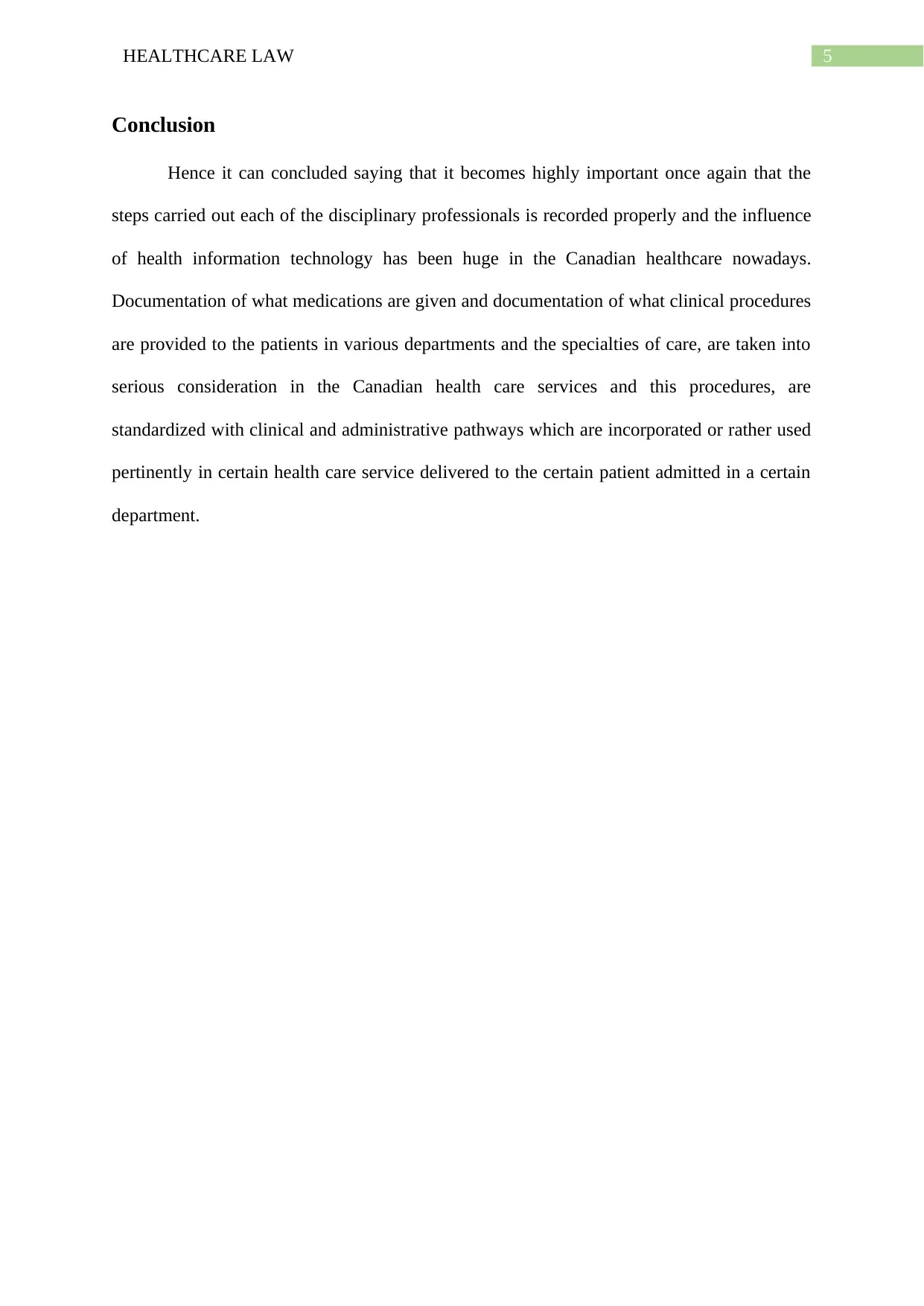
5HEALTHCARE LAW
Conclusion
Hence it can concluded saying that it becomes highly important once again that the
steps carried out each of the disciplinary professionals is recorded properly and the influence
of health information technology has been huge in the Canadian healthcare nowadays.
Documentation of what medications are given and documentation of what clinical procedures
are provided to the patients in various departments and the specialties of care, are taken into
serious consideration in the Canadian health care services and this procedures, are
standardized with clinical and administrative pathways which are incorporated or rather used
pertinently in certain health care service delivered to the certain patient admitted in a certain
department.
Conclusion
Hence it can concluded saying that it becomes highly important once again that the
steps carried out each of the disciplinary professionals is recorded properly and the influence
of health information technology has been huge in the Canadian healthcare nowadays.
Documentation of what medications are given and documentation of what clinical procedures
are provided to the patients in various departments and the specialties of care, are taken into
serious consideration in the Canadian health care services and this procedures, are
standardized with clinical and administrative pathways which are incorporated or rather used
pertinently in certain health care service delivered to the certain patient admitted in a certain
department.
⊘ This is a preview!⊘
Do you want full access?
Subscribe today to unlock all pages.

Trusted by 1+ million students worldwide
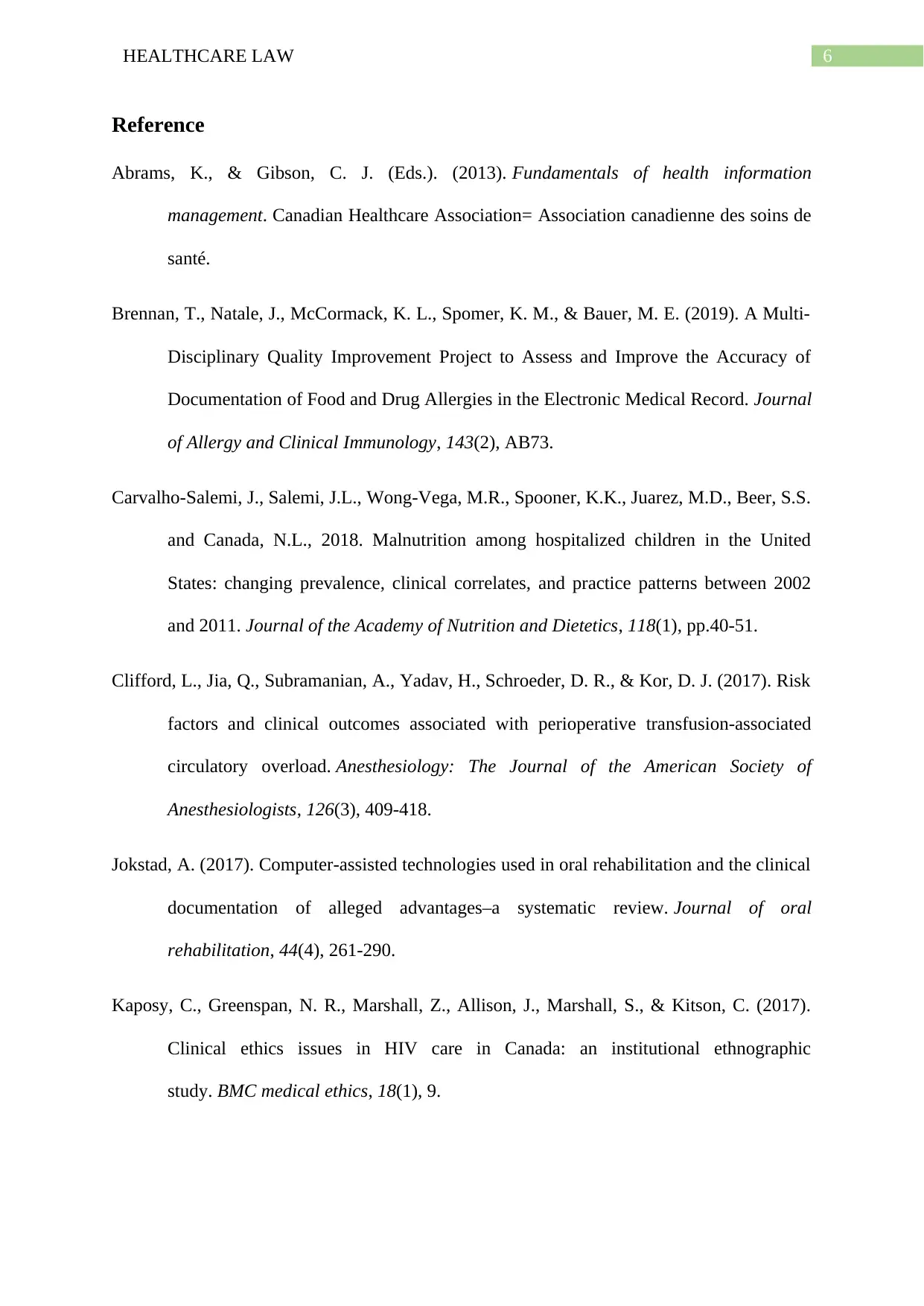
6HEALTHCARE LAW
Reference
Abrams, K., & Gibson, C. J. (Eds.). (2013). Fundamentals of health information
management. Canadian Healthcare Association= Association canadienne des soins de
santé.
Brennan, T., Natale, J., McCormack, K. L., Spomer, K. M., & Bauer, M. E. (2019). A Multi-
Disciplinary Quality Improvement Project to Assess and Improve the Accuracy of
Documentation of Food and Drug Allergies in the Electronic Medical Record. Journal
of Allergy and Clinical Immunology, 143(2), AB73.
Carvalho-Salemi, J., Salemi, J.L., Wong-Vega, M.R., Spooner, K.K., Juarez, M.D., Beer, S.S.
and Canada, N.L., 2018. Malnutrition among hospitalized children in the United
States: changing prevalence, clinical correlates, and practice patterns between 2002
and 2011. Journal of the Academy of Nutrition and Dietetics, 118(1), pp.40-51.
Clifford, L., Jia, Q., Subramanian, A., Yadav, H., Schroeder, D. R., & Kor, D. J. (2017). Risk
factors and clinical outcomes associated with perioperative transfusion-associated
circulatory overload. Anesthesiology: The Journal of the American Society of
Anesthesiologists, 126(3), 409-418.
Jokstad, A. (2017). Computer‐assisted technologies used in oral rehabilitation and the clinical
documentation of alleged advantages–a systematic review. Journal of oral
rehabilitation, 44(4), 261-290.
Kaposy, C., Greenspan, N. R., Marshall, Z., Allison, J., Marshall, S., & Kitson, C. (2017).
Clinical ethics issues in HIV care in Canada: an institutional ethnographic
study. BMC medical ethics, 18(1), 9.
Reference
Abrams, K., & Gibson, C. J. (Eds.). (2013). Fundamentals of health information
management. Canadian Healthcare Association= Association canadienne des soins de
santé.
Brennan, T., Natale, J., McCormack, K. L., Spomer, K. M., & Bauer, M. E. (2019). A Multi-
Disciplinary Quality Improvement Project to Assess and Improve the Accuracy of
Documentation of Food and Drug Allergies in the Electronic Medical Record. Journal
of Allergy and Clinical Immunology, 143(2), AB73.
Carvalho-Salemi, J., Salemi, J.L., Wong-Vega, M.R., Spooner, K.K., Juarez, M.D., Beer, S.S.
and Canada, N.L., 2018. Malnutrition among hospitalized children in the United
States: changing prevalence, clinical correlates, and practice patterns between 2002
and 2011. Journal of the Academy of Nutrition and Dietetics, 118(1), pp.40-51.
Clifford, L., Jia, Q., Subramanian, A., Yadav, H., Schroeder, D. R., & Kor, D. J. (2017). Risk
factors and clinical outcomes associated with perioperative transfusion-associated
circulatory overload. Anesthesiology: The Journal of the American Society of
Anesthesiologists, 126(3), 409-418.
Jokstad, A. (2017). Computer‐assisted technologies used in oral rehabilitation and the clinical
documentation of alleged advantages–a systematic review. Journal of oral
rehabilitation, 44(4), 261-290.
Kaposy, C., Greenspan, N. R., Marshall, Z., Allison, J., Marshall, S., & Kitson, C. (2017).
Clinical ethics issues in HIV care in Canada: an institutional ethnographic
study. BMC medical ethics, 18(1), 9.
Paraphrase This Document
Need a fresh take? Get an instant paraphrase of this document with our AI Paraphraser
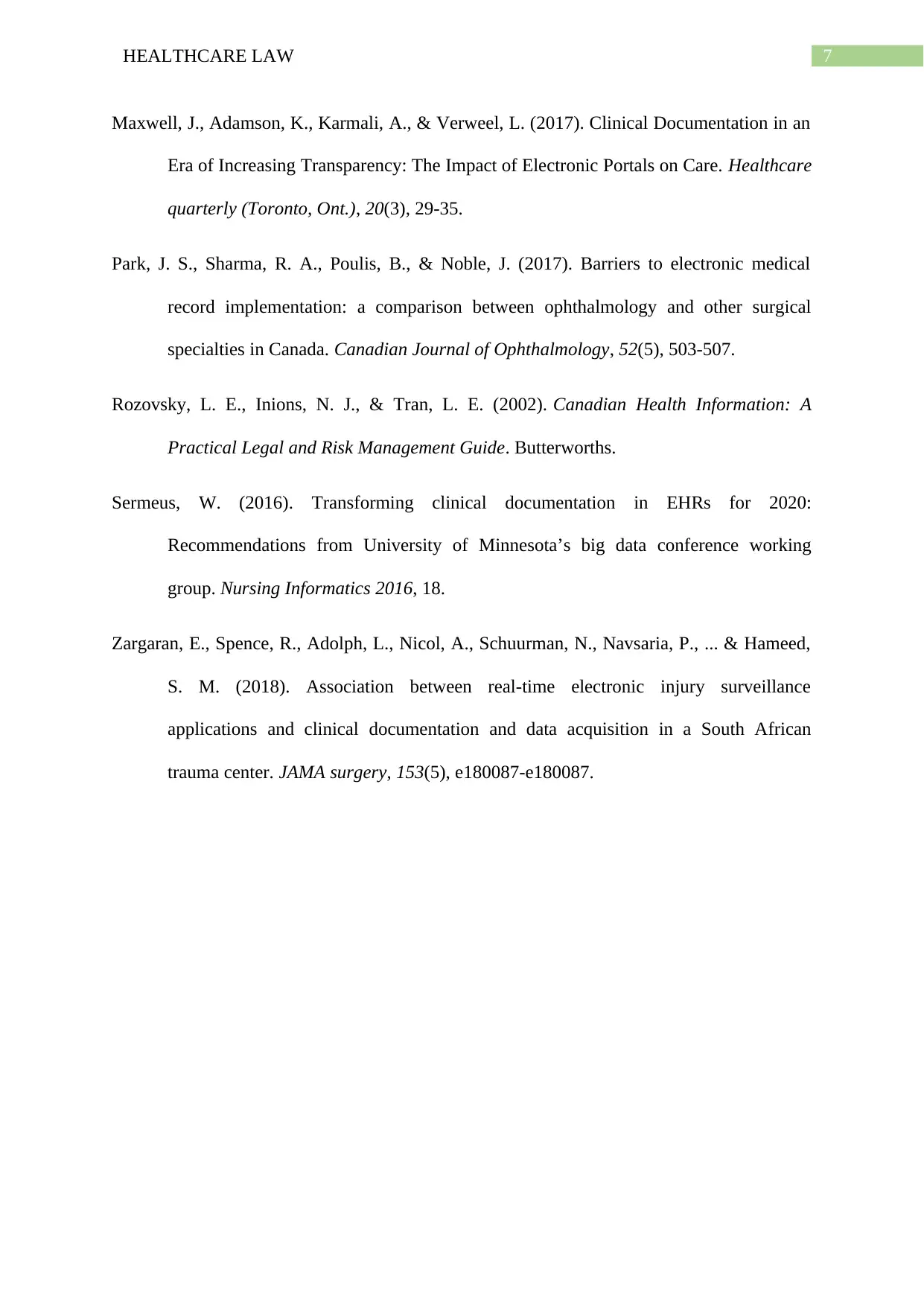
7HEALTHCARE LAW
Maxwell, J., Adamson, K., Karmali, A., & Verweel, L. (2017). Clinical Documentation in an
Era of Increasing Transparency: The Impact of Electronic Portals on Care. Healthcare
quarterly (Toronto, Ont.), 20(3), 29-35.
Park, J. S., Sharma, R. A., Poulis, B., & Noble, J. (2017). Barriers to electronic medical
record implementation: a comparison between ophthalmology and other surgical
specialties in Canada. Canadian Journal of Ophthalmology, 52(5), 503-507.
Rozovsky, L. E., Inions, N. J., & Tran, L. E. (2002). Canadian Health Information: A
Practical Legal and Risk Management Guide. Butterworths.
Sermeus, W. (2016). Transforming clinical documentation in EHRs for 2020:
Recommendations from University of Minnesota’s big data conference working
group. Nursing Informatics 2016, 18.
Zargaran, E., Spence, R., Adolph, L., Nicol, A., Schuurman, N., Navsaria, P., ... & Hameed,
S. M. (2018). Association between real-time electronic injury surveillance
applications and clinical documentation and data acquisition in a South African
trauma center. JAMA surgery, 153(5), e180087-e180087.
Maxwell, J., Adamson, K., Karmali, A., & Verweel, L. (2017). Clinical Documentation in an
Era of Increasing Transparency: The Impact of Electronic Portals on Care. Healthcare
quarterly (Toronto, Ont.), 20(3), 29-35.
Park, J. S., Sharma, R. A., Poulis, B., & Noble, J. (2017). Barriers to electronic medical
record implementation: a comparison between ophthalmology and other surgical
specialties in Canada. Canadian Journal of Ophthalmology, 52(5), 503-507.
Rozovsky, L. E., Inions, N. J., & Tran, L. E. (2002). Canadian Health Information: A
Practical Legal and Risk Management Guide. Butterworths.
Sermeus, W. (2016). Transforming clinical documentation in EHRs for 2020:
Recommendations from University of Minnesota’s big data conference working
group. Nursing Informatics 2016, 18.
Zargaran, E., Spence, R., Adolph, L., Nicol, A., Schuurman, N., Navsaria, P., ... & Hameed,
S. M. (2018). Association between real-time electronic injury surveillance
applications and clinical documentation and data acquisition in a South African
trauma center. JAMA surgery, 153(5), e180087-e180087.
1 out of 8
Related Documents
Your All-in-One AI-Powered Toolkit for Academic Success.
+13062052269
info@desklib.com
Available 24*7 on WhatsApp / Email
![[object Object]](/_next/static/media/star-bottom.7253800d.svg)
Unlock your academic potential
Copyright © 2020–2025 A2Z Services. All Rights Reserved. Developed and managed by ZUCOL.





